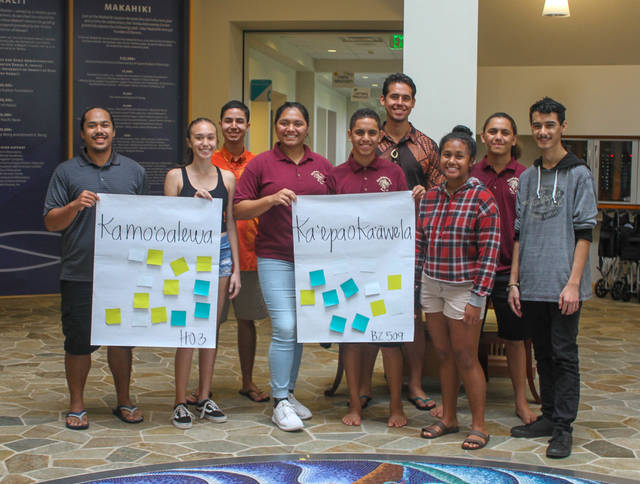HILO — Hawaiian language experts and astronomers are teaming up to name more discoveries in a way that doesn’t just allow them to be cataloged and tracked.
The goal also is to connect the celestial objects with the host culture through ‘olelo Hawaii, and share that knowledge with the rest of the world.
An example is the naming of ‘Oumuamua — the first known interstellar space rock — by Larry Kimura, an associate professor of Hawaiian language at the University of Hawaii at Hilo, in 2017.
But the effort also involves students, some of whom have submitted Hawaiian names for two unusual asteroids discovered by a Hawaii telescope to the International Astronomical Union.
About 10 Hawaiian immersion students spent two days at the ‘Imiloa Astronomy Center in Hilo last October, meeting with language experts and scientists to come up with the names for the objects discovered, like ‘Oumuamua, with Pan-STARRS on Haleakala. The workshop was a pilot for the new naming program called A Hua He Inoa.
They chose Ka‘epaoka‘awela — meaning mischievous opposite-moving companion of Jupiter — for an asteroid near Jupiter that’s moving in the opposite direction, and Kamo‘oalewa — which alludes to an oscillating celestial object.
If accepted by the IAU, they will become the official names for the objects, which would otherwise only be known by a series of numbers or letters.
This way, they are giving the objects an identity, and helping elevate Hawaiian language and culture to a larger stage, organizers noted.
“When we’re naming these things, they are more like people,” said Larry Kimura, who teamed up with Ka‘iu Kimura, his niece and ‘Imiloa executive director, and others to create the program.
“In Hawaiian tradition, everything is related.”
Ka‘iu Kimura said more workshops will be held with students, and the program intends to work with teachers at Hawaiian immersion schools to create a curriculum for their classrooms.
“We would like to normalize this process and have it be ongoing, and give the opportunity to our younger generation,” she said.
Beyond that, observatories are committing to give a Hawaiian name to any major discovery made from their Hawaii telescopes, including on Maunakea, Ka‘iu Kimura said.
The idea was thought of two years ago by John De Fries, a Hawaii businessman.
In a 2017 memo to the Kahu Ku Mauna advisory council for the Office of Maunakea Management, he asked that future telescope leases require use of the language when naming discoveries.
“My personal interpretation suggests that astronomy on Maunakea in these contemporary times is tantamount to the study of and research into the Genealogy of Wakea,” he wrote.
“Within this cultural context, new astronomical discoveries could be a spirit-guardian, an ancestor or a descendant of the sacred lineage of Ohana Wakea, Papahanaumoku and Ho‘ohokukalani.”
The naming program, the only one of its kind, is already catching on in the broader astronomy community.
Ka‘iu Kimura was recently the keynote speaker of the American Astronomical Society conference in Seattle, where she discussed A Hua He Inoa.
“Literally, I got inundated after that with astronomers wanting me to name some of their work,” she said. “We have a long list of things people would like names for in Hawaiian.”
Part of the interest may have been sparked by ‘Oumuamua, which means scout or first messenger.
Doug Simons, Canada-France-Hawaii Telescope director, attributes the massive media attention the object received to its unusual nature and the name itself.
“It was a remarkable discovery and a remarkable name for it,” said Simons, who is part of A Hua He Inoa and asked Larry Kimura to name it.
“… That really drove home to Larry how this idea, how Hawaiian names being given an international stage, could really be successful. … That was kind of the turning point.”
‘Oumuamua wasn’t the first discovery to be named using the Hawaiian language.
For instance, a galaxy super cluster that includes the Milky Way is known as Laniakea, meaning “immeasurable heaven.” There’s also Haumea, a dwarf planet in the outer solar system, named after a goddess.
What’s different is the ongoing commitment from astronomers to apply Hawaiian language to their work, and learn more about the host culture in the process.
Simons also attended the conference, and mentioned Ka‘iu Kimura received a standing ovation in the middle of her presentation, which is unusual for such conferences.
“I think it showed on an organic level how culture and science can be mutually supportive of each other,” he said.
Larry Kimura noted the naming of celestial objects isn’t new to Polynesians, who as master ocean navigators used the stars to guide them.
But he sees similarities between revitalization of the language and looking back in time to the ancient universe. Larry Kimura thinks both practices can support each other.
“The more we look for where we come from, the more, hopefully, the more we can find out where we are going,” he said.
Email Tom Callis at tcallis@hawaiitribune-herald.com.

